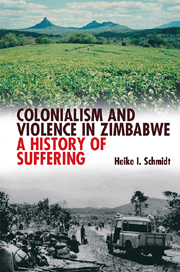5 - War Rages Hot
Insurgency & Counter-insurgency
Published online by Cambridge University Press: 05 May 2013
Summary
The Second Chimurenga, Zimbabwe's liberation war of the 1970s, is a prime example of guerrilla warfare, both of how it was fought by each side and how it affected the non-combatant population. This chapter examines these questions in unprecedented detail and in so doing addresses major queries that have been at the core of debate since the end of the Cold War, namely: What is political violence and how is it enacted, and how can a state legitimately counter insurgent violence? Eric Hobsbawm's challenge to the historical study of nationalism, to examine the phenomenon from both above and below, provides the necessary approach to gain a new understanding of guerrilla warfare. The Honde valley, as one of the most hotly contested areas of the entire conflict, is pertinent to this discussion. For this study, and for the first time, it was possible to gain access to the necessary evidence to reconstruct in detail the strategies and tactics employed by the guerrilla fighters and by the Rhodesian counter-insurgency initiative, as well as gain insight into the experiences of the affected rural population. The sources encompass the minutes of all the defence committee meetings for the Honde Valley and interviews with those having been involved in the conflict in a range of capacities. What transpires is a liberation war with a political agenda and daily tactics which were enacted in shifting microcosms of local support structures and the presence of the enemy.
- Type
- Chapter
- Information
- Colonialism and Violence in ZimbabweA History of Suffering, pp. 151 - 210Publisher: Boydell & BrewerPrint publication year: 2013

